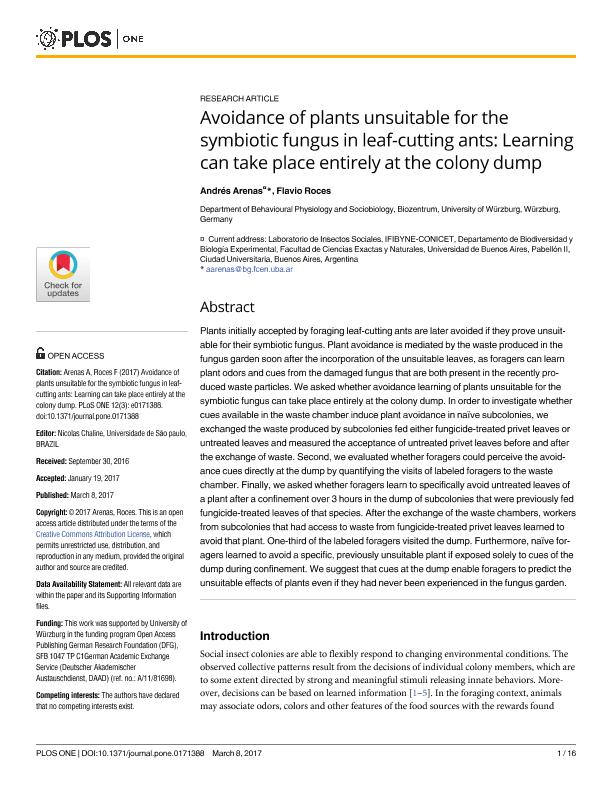Mostrar el registro sencillo del ítem
dc.contributor.author
Arenas, Andres

dc.contributor.author
Roces, Flavio

dc.date.available
2018-11-26T20:14:44Z
dc.date.issued
2017-03-08
dc.identifier.citation
Arenas, Andres; Roces, Flavio; Avoidance of plants unsuitable for the symbiotic fungus in leaf-cutting ants: Learning can take place entirely at the colony dump; Public Library of Science; Plos One; 12; 3; 8-3-2017; 1-16; e0171388
dc.identifier.issn
1932-6203
dc.identifier.uri
http://hdl.handle.net/11336/65220
dc.description.abstract
Plants initially accepted by foraging leaf-cutting ants are later avoided if they prove unsuitable for their symbiotic fungus. Plant avoidance is mediated by the waste produced in the fungus garden soon after the incorporation of the unsuitable leaves, as foragers can learn plant odors and cues from the damaged fungus that are both present in the recently produced waste particles. We asked whether avoidance learning of plants unsuitable for the symbiotic fungus can take place entirely at the colony dump. In order to investigate whether cues available in the waste chamber induce plant avoidance in naïve subcolonies, we exchanged the waste produced by subcolonies fed either fungicide-Treated privet leaves or untreated leaves and measured the acceptance of untreated privet leaves before and after the exchange of waste. Second, we evaluated whether foragers could perceive the avoidance cues directly at the dump by quantifying the visits of labeled foragers to the waste chamber. Finally, we asked whether foragers learn to specifically avoid untreated leaves of a plant after a confinement over 3 hours in the dump of subcolonies that were previously fed fungicide-Treated leaves of that species. After the exchange of the waste chambers, workers from subcolonies that had access to waste from fungicide-Treated privet leaves learned to avoid that plant. One-Third of the labeled foragers visited the dump. Furthermore, naïve foragers learned to avoid a specific, previously unsuitable plant if exposed solely to cues of the dump during confinement. We suggest that cues at the dump enable foragers to predict the unsuitable effects of plants even if they had never been experienced in the fungus garden.
dc.format
application/pdf
dc.language.iso
eng
dc.publisher
Public Library of Science

dc.rights
info:eu-repo/semantics/openAccess
dc.rights.uri
https://creativecommons.org/licenses/by-nc-sa/2.5/ar/
dc.subject
Leaf-Cutting Ants
dc.subject
Olfactory Learning
dc.subject
Delayed Avoidance
dc.subject
Waste Chamber
dc.subject.classification
Otras Ciencias Biológicas

dc.subject.classification
Ciencias Biológicas

dc.subject.classification
CIENCIAS NATURALES Y EXACTAS

dc.title
Avoidance of plants unsuitable for the symbiotic fungus in leaf-cutting ants: Learning can take place entirely at the colony dump
dc.type
info:eu-repo/semantics/article
dc.type
info:ar-repo/semantics/artículo
dc.type
info:eu-repo/semantics/publishedVersion
dc.date.updated
2018-10-23T18:08:41Z
dc.journal.volume
12
dc.journal.number
3
dc.journal.pagination
1-16; e0171388
dc.journal.pais
Estados Unidos

dc.journal.ciudad
San Francisco
dc.description.fil
Fil: Arenas, Andres. Universität Würzburg; Alemania. Consejo Nacional de Investigaciones Científicas y Técnicas. Oficina de Coordinación Administrativa Ciudad Universitaria. Instituto de Fisiología, Biología Molecular y Neurociencias. Universidad de Buenos Aires. Facultad de Ciencias Exactas y Naturales. Instituto de Fisiología, Biología Molecular y Neurociencias; Argentina
dc.description.fil
Fil: Roces, Flavio. Universität Würzburg; Alemania
dc.journal.title
Plos One

dc.relation.alternativeid
info:eu-repo/semantics/altIdentifier/doi/http://dx.doi.org/10.1371/journal.pone.0171388
dc.relation.alternativeid
info:eu-repo/semantics/altIdentifier/url/https://journals.plos.org/plosone/article?id=10.1371/journal.pone.0171388
Archivos asociados
